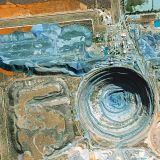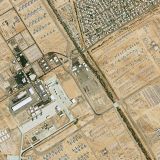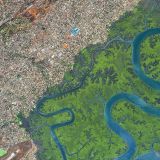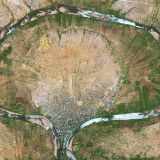Gerald Mansberger & Markus Eisl
eoVision
The Human Footprint
Lindenhof
From the densely populated cities to the inhospitable deserts of the Sahara and the icy wastes of Antarctica, we humans have now left our mark, our footprint, almost everywhere, reshaping the Earth to widely varying degrees.
No technology is as suitable as satellite remote sensing when it comes to showing our impact on the environment. From an altitude of a few hundred kilometres, high-quality
cameras today constantly capture images of Earth’s surface. From the hotspots of human activity such as pulsating megacities, from small towns and villages as well as from remote regions of Earth that have hardly been touched by humans, images with a resolution of up to 30 centimetres are continuously delivered. By comparing these images with older ones, the development of the human footprint can be recorded in detail.
In addition to the content of the satellite images, it is always the aesthetic impression that makes the images a unique combination of a document of time and visually impressive photographs.
Founded in 2008 in Salzburg, Austria, eoVision has since the beginning been involved not only in the technical evaluation of satellite data, but also in the processing of aesthetically high-quality images with meaningful content in order to convey the beauty and vulnerability of Earth to a wider audience. In cooperation with satellite operators such as Maxar, Airbus and European Space Imaging, Markus Eisl and Gerald Mansberger have designed numerous exhibitions, non-fiction books, atlases and the illustrated book series “Human Footprint”, which deal with different sub-areas of this topic.
Curated by Lois Lammerhuber / Printed by ![]()
Discover here contributions of ETH Zurich to the Sustainable Development Goal (SDG) 11:
Linking up rural with urban
Sacha Menz
Prof. Sacha Menz is a professor of Architecture and Building Process at ETH Zürich and, since 2020, director of the Future Cities Laboratory (FCL G).
His fascination for cities came as a child while traveling through Italy. Most of the cities built during the Renaissance and the Eighteen-Hundreds are fantastic examples of livable urban developments. They implement human scale and publicly available space and offer economic opportunities.
Researching cities through a transdisciplinary lens
FCL G is a research programme focused on studying and improving cities and the surrounding suburban and rural areas through a transdisciplinary lens. The work of FCL G goes beyond traditional academic boundaries, promoting collaboration and knowledge exchange among experts from different fields.
FCL G explores innovative methods and techniques to address the complex challenges faced by cities. It investigates how different disciplines can contribute to finding solutions for urban problems, whether it is through scientific analysis, creative design concepts, efficient engineering practices, or effective governance strategies.
Fostering interdependencies between rural and urban areas
FCL G is building public awareness on the challenges and opportunities of modern urbanism and facilitating the communication between researchers, stakeholders and citizens.
As urban areas continue to expand, there is a growing disparity in resources, opportunities, and services between cities and their surrounding regions. Cities often attract more investments, infrastructure development, and job opportunities, which leads to an imbalance in economic growth and employment prospects. This imbalance creates a cycle where people from suburban or rural areas are drawn to cities in search of better livelihoods, resulting in increased population density and strain on urban infrastructure.
Sacha Menz wishes that people would think and act more regional than global. Unequal dependencies between rural areas and cities are growing. We need more interdependencies.
“Equal opportunities should be created through large-scale knowledge dissemination. This starts in every home, by educating children, and needs to spread to schools and universities.”
Prof. Dr. Sacha Menz, Director of the Future Cities Laboratory (FCL G) at ETH Zurich
Disrupting the system with vertical farms
YASAI
Mark E. Zahran, a Swiss architect, developed a profound interest in the concept of vertical farming within urban environments while pursuing his studies in Mexico. This fascination was ignited by his reading of the book „The Vertical Farm: Feeding the World in the 21st Century“ authored by Dickson Despommier. Mark’s enthusiasm for the idea grew exponentially, leading him to personally meet the author soon after. In 2019, his startup YASAI received the ETH-Spin-Off label.
Vertical Farming
YASAI built Switzerland’s biggest Vertical Farm in Niederhasli, Zurich, to showcase this new more efficient way of growing plants. It’s called Vertical Farming, because YASAI stacks their yield on top of each other on up to six layers, like in a warehouse.
This kind of food production is more sustainable, because they save precious space and can produce up to 200x more yield per square meter. Through circular systems, they use 95% less fresh water than traditional agriculture. There is no need to apply any chemical pesticides either, because their plants grow in a safe and controlled environment.
YASAI wishes to disrupt the current food system by making it more sustainable and resilient. Usually, fresh herbs are imported to Switzerland eight months of the year. With YASAI producing herbs locally all year round, they can avoid food miles and food waste caused by it.
Making conscious food choices
YASAI aims to connect people and plants. Vertical Farms will be an intrinsic part of urban environments and integrated as infrastructures in major cities all around the world. They are creating more resilient and self-sufficient habitats for humans as well as other species to thrive.
The choices we make in what we consume have a significant impact on both our society and the health of our planet. It is becoming increasingly clear that a healthy diet not only benefits our personal well-being but also contributes to a healthier planet overall. By embracing a healthy and balanced lifestyle, everyone can actively contribute to creating positive change.
While technology has a role to play in promoting a more sustainable food system, it is essential for consumers to recognize their own responsibility in making a real impact. By making mindful decisions about the food we purchase, we can collectively make a difference.
“Let’s go vertical and grow more with less!”
Mark E. Zahran, Co-CEO of YASAI
Going circular with construction
Catherine De Wolf
Prof. Dr. Catherine De Wolf has a multidisciplinary background in civil engineering and architecture. Since she was a little girl growing up, she loved playing with Legos. She would build something, unbuild it, and then build something new with the same building blocks. This made her interested in circular economy principles in architecture and technologies that could foster reuse and regeneration in construction.
Catherine was always fascinated by the contrast between the rational side of engineering and mathematics and the creative side of architecture. She decided to combine both. With emerging digital innovation, she is convinced that technologies can be harnessed for the good.
Overcoming the linearity of the construction sector
The construction sector pollutes, generates waste and depletes resources. In Switzerland, more than 65% of all waste comes from the construction and demolition sector. Why is this? The sector traditionally builds in a linear way; it extracts, produces, uses, and disposes of buildings and building materials at the end of its lifecycle.
What we would need is a circular economy in which we use our buildings as long as possible and then reuse our building materials and components, giving them a new life, rather than downcycling or landfilling them.
Catherine saw it as her calling to ensure that less material was wasted, so she created the Circular Engineering for Architecture (CEA) Lab. In her research, she studies digital transformation to make circular construction more efficient.
Through digital tools and technologies, Catherine enables inclusive collaboration and knowledge sharing, enhancing safety by identifying and addressing hazards before construction begins. By embracing these digital and circular approaches, cities can become more inclusive, safe, resilient, and sustainable for their inhabitants. Moreover, the obvious environmental benefit of circular construction helps in tackling our climate crisis.
Circularity as a solution
Catherine De Wolf hopes that the principles of circular construction can be embraced in everyone’s own sphere of influence. Whether you are an architect, engineer, contractor, policymaker, or simply an individual interested in sustainable living, there are actions you can take to contribute to the circular construction movement. Educate yourself about circular design strategies, promote resource optimization and waste reduction in construction projects, and advocate for the adoption of digital technologies that enable circularity.
“My vision for a sustainable future is a regenerative construction sector. Collaboration among stakeholders is vital, breaking down silos and fostering partnerships to ensure sustainable practices throughout the construction lifecycle.”
Prof. Dr. Catherine De Wolf, Head of the Circular Engineering for Architecture (CEA) Lab at ETH Zurich
open your eyes festival buerau
Botenaustrasse 42
9443 Widnau
Switzerland
Phone: +41 44 218 11 03





